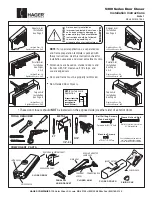
- 4 -
SECURITY OF WORK WHILE WELDING OF METALS
CONTAINING LEAD, CADMIUM, ZINK, MERCURY
AND GLUCINUM
Make specific precautions if you weld metals con-
taining these metals:
Do not carry out welding processes on gas, oil,
fuel etc. tanks (even empty ones) because there
is
the risk of an explosion. Welding can be car-
ried out only according to specific regulations!
In spaces with the risk of an explosion there are
specific regulations valid.
ELECTRIC SHOCK PREVENTION
This apparatus is an electrical device
presenting a serious danger of injury
or fatal accident if it is handled unpro-
fessionally or negligently by person
coming into contact with it.
Welding apparatuses must be operated and handled
only by qualified and properly trained persons. The
operator must observe the requirements of the
following standards EN 60974-1, EN 050601, 1993,
EN 050630, 1993 and all other safety provisions so
that his/her safety and safety of third persons is
guaranteed. All connections must comply with the
current regulations and standards, namely EN
332000-5-54, EN 60974-1 and accident prevention
related legislation.
This apparatus is the Class I device that may be sup-
plied with power only from the mains socket outlet
connected with the protective conductor that is
consequently connected to the equipment (the
conductor must not interrupted in any case - e.g. in
an extension cable). If not, there is a serious danger
of electric shock.
Please make sure that the apparatus is properly
earthed and connect with the earth also the work
area and the weldment.
If not properly covered, the apparatus is not de-
signed for any outdoor work while raining.
Do not conduct any welding operation under wet
conditions or in a wet environment or in rain. Do not
use welding torch, welding or power supply cables of
insufficient cross-sections. Always check the welding
torch, welding or power supply cables and make sure
that their insulation is intact and if the conductors
are not loose in the connections. Cables and socket
outlets must be checked in regular intervals for their
compliance with the relevant safety codes and
standards. Do not use the apparatus with missing or
damaged covers!
If consumable parts are to be replaced (e.g. in the
welding torch), switch the apparatus off using the
mains switch.
All repair and maintenance procedures may be
carried out only if the apparatus is disconnected
from the mains!
All repairs, replacements and adjustments may be
carried only by the servicing personnel authorised by
manufacturer. The parts that might affect the occu-
pational safety (e.g. main switches, transformers,
etc.) may be replaced only with original spare parts.
After each replacement, safety tests must be con-
ducted (visual inspection, protective conductor test,
insulation strength measurement, leakage current
measurement and functional tests).
BURN INJURIES DURING WELDING
Always use the personal protective
equipment for welders and protect all
parts of your body during welding
operations! Always use protective clothing, safety
footwear, splinter-proof goggles and protective
gloves. This personal protective equipment protects
you not only against melted metal splashing and
contact with hot spots, but also against dangerous
ultraviolet radiation resulting in welding operations.
Please be aware that UV radiation may
cause serious health problems. Never
conduct any welding operation while
your clothing is contaminated with
paints and/or other combustible sub-
stances.
Please be aware that high temperatures occur at
some parts of the apparatus: such as the tip of the
welding wire or torch.
COMBUSTION GASES PRODUCED DURING WELDING
Use the welding set only in well ventilated areas. The
electric discharge produces ozone gas that may -
even at low concentrations - cause irritation of mu-
cous membranes and headache. At higher concen-
trations, ozone gas is noxious.
Provide for proper ventilation of your workplace!
Keep the working place clean and provide for remov-
ing of all gases created during welding operations,
particularly in confined premises! If it is not possible
to provide for clean air supply, use suitable respira-
tors. If a good-quality respirator (capable of filtration
of gaseous chemical products) is not available, do
not weld any metals containing lead, graphite,
chromium, zinc, cadmium and beryllium. Many sub-
stances, otherwise deemed harmless, may turn in
the contact with the welding arc to dangerous sub-
stances.
In order to avoid releasing of noxious gases, remove
all paints, impurities and greasy substances present
at the places for welding.
WELDING ASSOCIATED WITH RADI-
ATION
A wide radiation spectrum is created
during welding; UV radiation is the
Summary of Contents for MW2040
Page 19: ...19 2080...





































